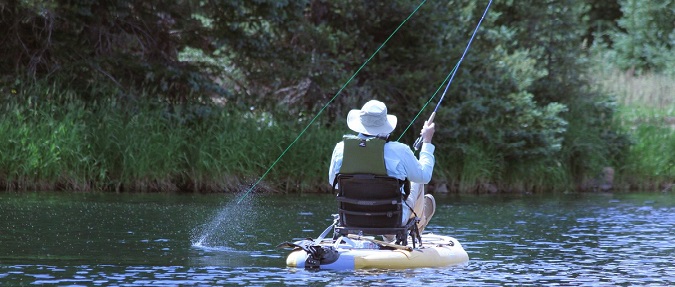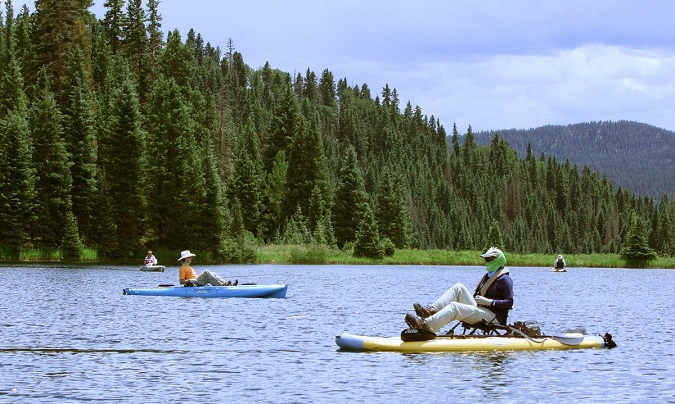
The sun had just risen over the mountain peaks as I walked into the dining room. I leaned gratefully against the cushioned backrest of my chair while sipping on a fresh mug of steaming hot coffee and massaging a pesky knot in my shoulder. “Are you okay?” my husband Philip asked.
“Actually, I think I pulled a muscle in my shoulder yesterday.”
“Ouch, how did you do that?” Mom asked, one hand already reaching for the ibuprofen in her pocket.
“Well, I think it happened while playing that last five-pound rainbow trout yesterday. The fight lasted longer than I thought.”
At that, Dad just chuckled and said, “I’m having a really hard time feeling sorry for you right now.”
Pulling a muscle while playing a fish is, I would argue, the epitome of a first world fishing problem and one I was more than happy to endure while fly fishing in the mountains of Chama, New Mexico. My parents, husband, and I recently teamed up with Hobie® for an unforgettable adventure to The Lodge and Ranch at Chama Land & Cattle Company in northern New Mexico’s soaring San Juan Mountains, a 36,000-acre ranch recognized world-wide for its premier elk hunting, five-star accommodations, and pristine high-country trout lakes and streams.
We wanted to demonstrate the effectiveness of the Hobie MirageDrive® kayaks in fly fishing on the mountain lakes, but we didn’t expect the unique fishing strategy that we would develop based on Hobie’s newly announced MirageDrive 180, which features the ability to switch to full-power reverse.
Philip and I rode in the pickup truck with our guide, Pat Carpenter, up to Charlie’s Lake for the first day of fishing. While we traversed the bumpy dirt roads that connect the ranch’s extensive network of lakes and game trails, we experienced the scenic beauty and unique species of wildlife that were a far cry from our home in Tennessee. Golden-mantled ground squirrels scurried among the rocks, a mother grouse hustled her young brood into the safety of the tall grass, and long-eared mule deer and muscular cow elk leaped across the road and scrambled up sheer embankments as nimbly as mountain goats. Eventually Charlie’s Lake came into view, an oasis of cold, pristine water shrouded by stands of aspen trees.
At first sight, Pat could tell that the trout were holding in deep water in response to the hot weather, as we saw almost no feeding activity at the surface. We would have to troll with full sinking lines and weighted Woolly Buggers, which was a strategy I had never used in the shallow mountain streams of East Tennessee. Pat and my parents took positions on the ranch’s jon boats, while Philip and I each launched an inflatable Hobie Mirage i11s.
The concept of trolling was relatively simple to understand. I stripped about twenty feet of line from the reel, let it sink, and began pedaling slowly forward in the deep water while holding my 4-piece, 9-foot, 6-weight Sage Xi3 in one hand and the rudder control in the other. After the first couple of circuits, I began feeling the occasional tentative nibble from a curious trout, but the angle at which I was holding the rod made it difficult to set the hook. Pat noticed my first couple of false starts and moved his jon boat closer. “Having any luck?”
“I’m getting bites, but I’m having a little trouble setting the hook. I’m not used to holding the rod out to one side.”
Pat thought for a moment, and then asked, “Hey, can that thing go in reverse?”
I immediately caught on to what he was thinking and grinned. “Why yes it can!”
A simple finger-pull switched the butter-smooth gears on the brand new MirageDrive 180 into reverse, and I began pedaling backwards. At first I had to laugh at myself for presenting what was, no doubt, a hilarious visual for everyone else on the lake. I was sitting on a kayak, moving backwards and constantly looking over my shoulder to ensure that the inflatable Mirage i11s didn’t collide with Philip’s kayak or the larger, heavier jon boats. On the other hand, holding my rod felt much more comfortable and natural, as I could hold it straight in front of me with the tip low and parallel to the water.
Barely five minutes, I felt the distinctive tug and lifted the rod tip straight up, securely setting the hook and sending the trout into a battle frenzy.
“FISH ON!” I called as the trout tried to dive for cover. I could feel the initial tension in the line weakening as I quickly tried to reel in all of the extra line. Almost instinctively, I kept pedaling backwards. The tension increased as I maintained the connection with the fish, and the rod tip bowed towards the water as she continued thrashing. Her silhouette flashed silver and green from beneath the water, and I gently guided her to the net as she broke the surface. She was a stunning 16-inch beauty, her colors standing out in bright pinks and greens against the dapples in her scales. The barbless hook easily slipped free, and we posed for a few quick photos before releasing her.
As the day continued, trolling in reverse proved its effectiveness repeatedly, as Philip and I caught a combined total of eight rainbow trout that day.
I hooked my last trout on what I intended to be my last trolling circuit, but I did not expect the sheer power and strength that bent my rod tip inches from the water and sent the line screaming from my reel.
I pedaled backwards almost as quickly as I was reeling to gain line, and I had to tighten the drag and give her ample time to wear herself out before she finally broke the surface. The fight lasted a solid five minutes, and I was breathing heavily from exertion in the thin mountain air when I finally brought her to the net.
Overall, the Hobie MirageDrive 180 allowed the kayak to become as much of a part of my fly fishing tackle as my rod and reel. When the MirageDrive 180 hits the market as an accessory (expected in mid-year 2017), I definitely plan on getting one to use on my own Mirage® Outback for kayak fishing on the lakes in Tennessee.
And yes, I may have woken up to a sore muscle after that first day of fishing, but I wouldn’t have traded the experience for anything in the world.

